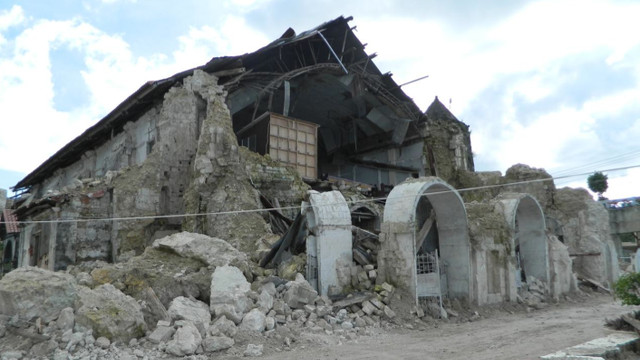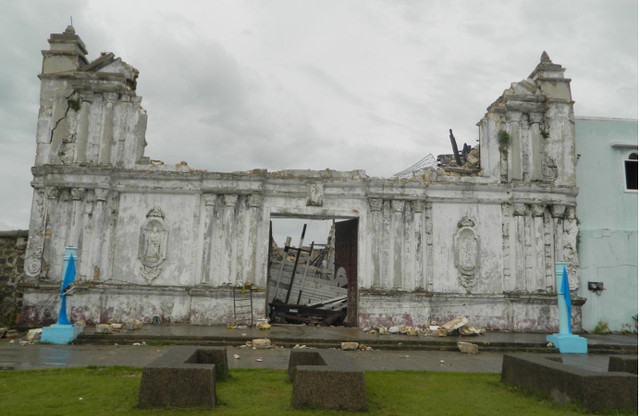SUMMARY
This is AI generated summarization, which may have errors. For context, always refer to the full article.

MANILA, Philippines – While all resources and assistance of most organizations are focused on relief and rebuilding lives in the aftermath of Typhoon Yolanda (Haiyan) and the Bohol earthquake, cultural agencies have also begun work on the restoration of priceless heritage structures damaged during the disasters.
Restoration work has been painfully slow, however, a team of heritage experts has reported.
Resources are spread thin, and there’s a lack of manpower, equipment, and funding, according to their report, a copy of which was given to Rappler.
A heritage assessment team has been jointly formed by the United Nations Educational, Scientific and Cultural Organization (UNESCO), the International Centre for the Study of the Preservation and Restoration of Cultural Property (ICCROM), and the government’s National Commission for Culture and the Arts (NCCA).
The team visited Samar, Leyte, Cebu, and Bohol from December 5 to 9 to document the damage caused by the disasters to various historic structures. They are tasked to formulate recommendations to guide restoration efforts. (READ: Cultural agencies to restore damaged heritage structures)
They appraised iconic churches, historic houses, and museums.
The group was composed of architect for UNESCO Stephen Kelley, Aparna Tandon of ICCROM, Filipino anthropologist for UNESCO Dr Vellorimo Sumngguit, and architect Joycelyn Mananghaya. They were chosen by NCCA and UNESCO to represent the Philippines during the mission.
They visited some of the most iconic churches in Visayas that sustained major damage, including:
- Church of the Immaculate Conception in Guiuan, Eastern Samar
- Church of San Pedro Apostol in Loboc, Bohol
- Church of Our Lady of Light in Loon, Bohol
- Santissima Trinidad Parish in Loay, Bohol
- Church of Our Lady of the Immaculate Conception in Baclayon, Bohol
- Santa Cruz Parish Church in Maribojoc, Bohol
- Santo Niño Parish Church in Cortes, Bohol
They also assessed the damage in non-church historic structures, like the Baclayon museum and the Clarin Ancestral House in Bohol.
Limited resources
Restoration of big, historical structures like churches require plenty of manpower and heavy equipment, which the disaster-crippled communities don’t have at the moment.
Such was the case in the restoration of Loon church (Church of Our Lady of Light), which was built in the 19th century and called the “Queen of All Heritage Churches in Bohol.” (WATCH: In 360: Iconic churches before Visayas quake)
ICCROM mission expert Aparna Tandon noted that “the retrieval operation was slow and needed equipment to expedite the work.”

A similar case was observed in Guiuan, Eastern Samar, where the team saw how the lack of carpenters and manpower for repairing 18th-century Guiuan church (Church of the Immaculate Conception) has hampered restoration efforts.
The problem is understandable: “The town people are focused on the recovery of their own lives as everybody was gravely affected as well by the typhoon,” said the report.
Guiuan was where Yolanda made its first landfall on November 8, leveling houses with freakishly strong winds and submerging communities with floods.
While the roof and upper portion of Guiuan church’s facade was completely ripped off by Yolanda, the team said the features which qualify the church as a National Cultural Treasure are largely intact. These include the elaborate shell ornaments on its walls that have made the church famous.
Loboc church (Church of San Pedro Apostol) is one of the Bohol churches in the worst condition.

The wall housing the church’s pipe organ is in a “seriously unstable” state. Though it is standing, the wall has buckled inward such that the buttress which once held the wall up is now pushing the wall inward.
If the wall moves or collapses, the pipe organ gallery will go down with it.
Too old to save?
The age and construction of the historic structures has made restoration efforts even more difficult.
Yolanda and the earthquake only exposed weaknesses that were bound to catch up with the structures sometime: gaps between ancient wood planks, decayed wooden beams (some eaten by termites), weak pillars and stone walls. Faulty construction also compromised the integrity of the buildings.
For example, the collapse of the front facade wall of the Loay church (Santissima Trinidad Parish) was partly due to the lack of connecting material between the old wall and a new portico facade added during the 19th century.
Disorganized restoration efforts and rough handling of some of the salvaged structural elements of the buildings also concerned the team.
In the case of Loon church (Church of Our Lady of Light), Tandon raised alarm over how stones from the church walls were placed haphazardly on the ground, which “may cause ground moisture to cause further damage to the stones.”
Those doing restoration work should have placed the stones on protective material like tarpaulin.
The 19th-century church was completely destroyed by the October 15 earthquake. Once the biggest church in Bohol, it is reduced to a giant mound of rubble. It will have to be rebuilt one stone at a time.
Local initiatives
In some communities, local groups, often with the help of their parish church, independently mobilized to begin the long, arduous task of restoring their heritage.
The Bohol Heritage Task Force, for example, is helping the National Museum retrieve and safeguard the historic churches in the province. The operation is being funded by the NCCA.
In Loon, the church has called on parishioners to raise funds needed for the reconstruction work.
The joint team’s report will serve as a basis for upcoming restoration programs by both the local and national cultural agencies.
After the assessment, the next step is to determine the needed funding for the rehabilitation and look for financial assistance.
The team also emphasized that rehabilitation should include the strengthening of the old structures against future disasters. – Rappler.com
Add a comment
How does this make you feel?
There are no comments yet. Add your comment to start the conversation.